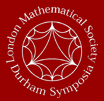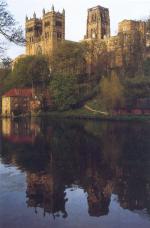 |
| Home |
| Outline |
| Key Speakers |
| Participants |
| Photo |
| Poster |
| Programme |
| Talks |
| Topics |
 |
| London Mathematical Society - EPSRC Durham Symposium |
| Geometry and Arithmetic of Lattices
|
| Monday 4th July - Thursday 14th July 2011
|
| Aim and scope of the symposium Lattices may be studied from different points of view, including topology, geometry and number theory. In addition, research in this area varies between the abstract and the concrete. There are many new results from one aspect of this topic that have impact on at least one of the others. This meeting will bring together people from a variety of backgrounds, but who all have an interest in lattices. By informing one another of recent progress and outlining open problems, we hope to learn from one another to advance this area of research. The topics covered by the conference will include: (1) Betti numbers and covers (2) Complex hyperbolic lattices (3) Counting lattices (4) Geometric properties (5) Non-arithmeticity (6) Reflection groups (7) Subgroup separability of hyperbolic lattices (8) Volumes Here are more details of these topics. (1) Betti numbers and covers One of the fundamental conjectures in hyperbolic geometry states that every hyperbolic n-manifold has a finite sheeted cover with positive first Betti number. The 3-dimensional case of this conjecture, which is often attributed to Thurston, is widely considered as the main open problem about the geometry and topology of closed 3-dimensional manifolds, now that Perelman has proved the Poincare and geometrisation conjectures. There are numerous results towards different cases of the first Betti number conjecture, which include a proof of the 3-dimensional surface subgroup conjecture for arithmetic hyperbolic 3-manifolds recently announced by Lackenby. Moreover, the question of non-vanishing of first Betti number is very much an active question for lattices in PU(n,1) and in some sense even more mysterious than the real hyperbolic case. Our plan is to discuss the recent developments with an emphasis on the higher dimensional real and complex cases. (2) Complex hyperbolic lattices One may construct lattices in PU(n,1), the holomorphic isometry group of complex hyperbolic space, in several different ways. Nevertheless, it is often hard to do so and there are relatively few explicit constructions known. Broadly speaking, there are four major constructions: arithmetic constructions, use of moduli of different objects, algebro-geometric constructions based on Yau's theorem and construction of fundamental domains. There are many connections between these approaches, and we plan to bring together experts in different areas in order to improve our understanding. A fake projective plane is the quotient space of a torsion-free uniform complex hyperbolic lattice of minimal covolume. Although the first example was given by Mumford in 1979, there is no explicit topological description of any of these manifolds. Recently Prasad and Yeung have classified fake projective planes. Fundamental domains for various lattices in PU(2,1) have been constructed recently by Deraux, Falbel, Parker and Paupert. Allcock, Carlson and Toledo have given new examples of complex hyperbolic lattices in high dimensions by considering the moduli space of geometric objects, such as cubic threefolds. By bringing these researchers together we aim to get a more unified understanding of complex hyperbolic lattices. (3) Counting lattices The study of distribution of lattices in Lie groups was initiated by Lubotzky in mid 90's in connection with the congruence subgroup problem and property $\tau$. Later on a significant progress in this area was achieved with important contributions by Belolipetsky, Gelander, Lubotzky, Mozes and Nikolov, to name a few. Having an opportunity to bring together the leading experts in this rapidly developing field, we plan to explore its possible connections with the other topics of the symposium. (4) Geometric properties Many algebraic and arithmetic properties of lattices are related with geometry of the locally symmetric spaces. This connection provides methods and ideas for studying various geometric questions. Using this type of approach Belolipetsky and Lubotzky showed that every finite group can be realised as a group of isomtries of a hyperbolic n-manifold for an arbitrary dimension $n$, which solved an old standing problem. Another example related to this topic is provided by the recent work of Leininger, McReynolds, Neumann, and Reid, and Prasad and Rapinchuk on lengths of closed geodesics and isospectral locally symmetric spaces. (5) Non-arithmeticity A group is called arithmetic if it is commensurable to the group of integral points in an algebraic group defined over the rationals. Borel and Harish-Chandra showed that all arithmetic groups are lattices. Conversely, Margulis showed that all lattices in irreducible Lie groups of rank at least two are arithmetic. Among the rank one groups, Corlette, Gromov and Schoen showed the same result for PSp(n,1) and F4(-20). This only leaves PO(n,1) and PU(n,1). Non-arithmetic lattices in PO(n,1) for all values of n were given by Gromov and Piatetski-Shapiro. The first non-arithmetic lattices in PU(2,1) were given by Mostow in 1980. In later work with Deligne, he found more non-arithmetic lattices in PU(2,1) and also a single example in PU(3,1). These are essentially the only examples known. For n>3 the problem is open. Recently Parker and Paupert have developed a new strategy that produces groups that are candidates for being non-arithmetic lattices in PU(2,1). Preliminary investigations indicate that this method will produce non-arithmetic lattices that are not commensurable with any of the previously known examples. (6) Reflection groups Hyperbolic reflection groups can be considered as a natural generalisation of the classical finite and affine Weyl groups. Their study gives rise to various interesting problems which are related to different subjects. Our prime interest is in a recent proof of the finiteness of the number of conjugacy classes of arithmetic maximal hyperbolic reflection groups which was given by Agol, Belolipetsky, Storm, and Whyte and, independently, by Nikulin following a previous work of Maclachlan, Reid and Long. This completes a project begun over 30 years ago by Vinberg, and opens new possibilities for classification of the hyperbolic reflection groups. An interesting open problem is to find analogous finiteness theorems for lattices in PU(n,1) generated by complex reflections. (7) Subgroup separability of hyperbolic lattices A theme that has been very fruitful recently is the interplay between questions about the topology of finite covers of hyperbolic manifolds (particularly in dimension 3) and virtual injections of their fundamental groups in right angled Artin groups or right angled Coxeter groups. This was used by Agol, Long and Reid to prove GFERF for many arithmetic lattices, and in extensions of their work by Bergeron, Haglund and Wise, and by Kapovich, Potyagailo and Vinberg. The latter relates questions of incoherence of lattices in PO(n,1) (for n>3) and the virtual fibering question in dimension 3. In addition, work of Agol on virtual fibering connects these questions to the topology of 4-manifolds, through work of Friedl and Vidussi on the Taubes Conjecture. (8) Volumes Volume is one of the principal invariants of locally symmetric spaces and, more generally, Riemannian manifolds. In 1968 Kazhdan and Margulis showed that any connected semisimple Lie group without compact factors contains a lattice of minimal covolume. Since then there has been a considerable interest in describing such extremal lattices and computing their covolumes. This problem for the groups of isometries of hyperbolic 3-space was solved in full generality only very recently by Gehring and Martin. More results are available if we restrict ourselves to arithmetic lattices, for which we have volume formulae due to Borel and Prasad. In particular, in a work of Belolipetsky the minimal covolume arithmetic hyperbolic lattices were determined for even dimensions, and in a recent PhD thesis of Emery this problem was solved for the odd dimensions. This leads to a number of open questions about geometric properties of the corresponding locally symmetric spaces which are related to other topics in our program. |
|
Organising Committee: Misha Belolipetsky (Durham), Martin Bridson (Oxford), Marc Lackenby (Oxford), John Parker (Durham) |
|
Scientific advisers: Misha Kapovich (UC Davis), Alan Reid (UT Austin) |